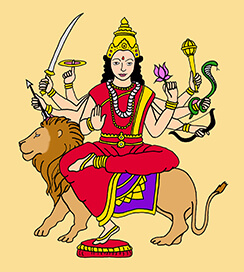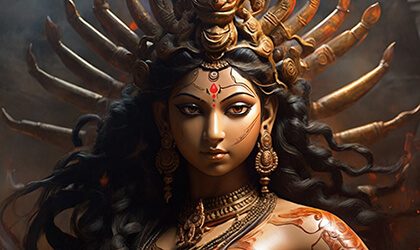Watch nearly 400 videos on the Vocal Medicine Channel!
Om Dum Durgayei Namaha
Durga’s primary mantra “OM Dum Durgayei Namaha” includes her seed syllable and name. Seed syllables are concentrated sounds in Sanskrit that embody a particular force or energy. Durga’s seed syllable is DUM (short form “duhm”; long form “doom”).
Share this page with a friend!
Durga’s Seed Syllable
The seed syllable DUM is a fire element syllable. This Durga mantra is a powerful fire mantra with a weapon-like effect. DUM is an earthly fire rather than an etheric fire. The martial energy of DUM overcomes opposition.
Long Vowel Form of “DUM”
DUM with a long vowel (pronounced doom) is similar but softer and more feminine. This form of DUM also neutralizes negative forces projected against us. DUM is beneficial for tissues in the body and can be used to burn away toxins and also to increase the digestive fire. DUM is a solar rather than a lunar energy. Read full article on seed syllables: One Word Mantras.

Om Dum Durgayei Namaha for Protection
Durga is known by many names including Bhagini (sister), Devi, Shakti and more. Durga personifies the vibration of the fierce mother, only moving into battle to protect her own and never for the sake of violence. In some circumstances, Durga leads a divine army. We’ll take a look at the meaning of “Om Dum Durgayei Namaha” in a word-by-word English translation.
The Meaning of OM
OM is believed to be a sound of the whole cosmic manifestation. OM is the sound of the universe, the sound from which all other sounds are formed. OM represents past, present and future. OM is a seed or building block of creation.
The Energy of “DUM”
DUM is also a transformative energy to eliminate sorrow and obstacles both within and without. DUM grants self-control. DUM combines protection and self-discipline, saving us from difficulties whenever possible.
Meaning of “Durgayei”
In Sanskrit, the name Durga means “inaccessible” or a “fortress.” Other translations of her name are “impassable, invincible, and unassailable.” Her name is related to the word “durg” which means “something difficult to defeat or pass.” Ultimately, Durga is “the undefeatable goddess.”
Meaning of “Namaha”
The chant is sometimes sung with the ending “svaha.” The ending “namah” or “namaha” means “I honor” or “I bow to.” The word svaha is usually associate with a fire offering. Svaha is traditionally used at certain times such as during certain astrological cycles.

Story of the Goddess Durga
Durga is associated with protection, strength, motherhood, destruction, and wars. The most famous legend about Durga is the killing of the buffalo demon, Mahishasura. After doing severe penance to appease Brahma, the Creator god, the buffalo demon asked for immortality. Brahma denied the plea, insisting that all things must die one day.
Pride of the Demon Mahishasura
Mahishasura appealed this decision, asking that only a woman could kill him. Mahishasura believed women to be powerless and weak. Brahma granted his wish. Afterwards, Mahishasura started to torture innocent people. He attacked and captured heaven without any fear.
Gifts to Durga from the Gods
To save the innocent people who were being harmed, the gods combined all of their energy to create Durga. Shiva formed Durga’s face. Yama, the god of death, gave her dark, black hair. Vishnu gave her many arms. Durga is generally shown with 8 to 10 arms. Vayu, the wind god, gave her a bow and arrow. The mountain god Himalaya gave her a lion to ride. As the recipient of their collective energy, she became greater than all. She emerged as the ultimate warrior goddess.
Weapons from the Gods
The gods gave her duplicates of all of their weapons to be held in her many hands. Like other goddesses, Durga is renowned for her beauty. Receiving their gifts and energy, Durga became the inner power or shakti for all of the gods. With her many weapons and impenetrable power, Durga fought Mahishasura and destroyed him.
Goddess Durga’s Unique Aspects
Durga is always depicted with a calm and serene face even in the midst of battle. This tranquility is derived from the fact that she only acts out of necessity. Durga does not fight for the pleasure of battle. She seeks only the good and the freedom those who depend on her. She is the guardian of the soul’s journey to liberation.
The Power of Durga’s Many Limbs
Durga’s many limbs allow her to always be ready for battle in any direction. She also has three eyes, like her consort Shiva. Durga’s left eye is associated with the moon, symbolizing desire and lunar energy. Her right eye is connected to the sun and symbolizes action or solar energy.
Durga’s Third Eye
The third eye in the middle of her forehead represents intuition and wisdom. Like Shiva, famous for shooting bolts of lightning from his third eye, Durga’s third eye is connected to the fire element. The three eyes also symbolize her vigilance. She is ever ready to do battle.
Additional Mantras to Durga
Three of Durga’s most common mantras are the following:
Om Hrim Krim Dum Durgayai Svaha (Durga’s Protection Mantra)
Om Dum Dugayei Namaha (Durga’s Primary Mantra)
Om Aim Hrim Klim Chamundaye Vichche (Chamunda Mantra)
OM DUM DURGAYEI NAMAHA ARTICLE SUMMARY
The story of Durga is the story of spiritual protection in the form of a Hindu goddess. Durga’s name means “fort” and her role is to defend her devotees. This article includes the meaning of her primary mantra: Om Dum Durgayei Namaha.
Click for all content on our Site Map
Author Kathleen Karlsen
Kathleen Karlsen is a musician, artist, writer and speaker. She is the author of two books (Flower Symbols and Vocal Medicine) and over 200 articles. Kathleen, her husband Andrew, and their five children live in Bozeman, Montana. More about Kathleen Karlsen.
Share this page with a friend!
![]() Vocal Medicine Music on Spotify!
Vocal Medicine Music on Spotify!





